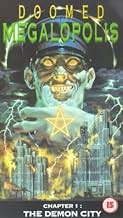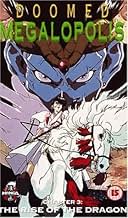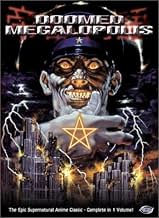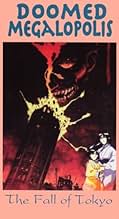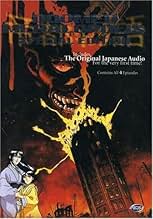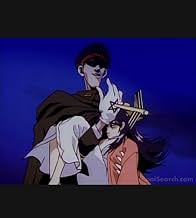Adicionar um enredo no seu idiomaSpiritual battle rages in 1908 Tokyo amid Western industrial influence. Onmyoji Yasumasa Hirai strives for prosperity, while evil Onmyoji Yasunori Kato seeks destruction. Their clash determi... Ler tudoSpiritual battle rages in 1908 Tokyo amid Western industrial influence. Onmyoji Yasumasa Hirai strives for prosperity, while evil Onmyoji Yasunori Kato seeks destruction. Their clash determines Tokyo's fate.Spiritual battle rages in 1908 Tokyo amid Western industrial influence. Onmyoji Yasumasa Hirai strives for prosperity, while evil Onmyoji Yasunori Kato seeks destruction. Their clash determines Tokyo's fate.
Explorar episódios
Avaliações em destaque
I watched this anime short series and have to say it was rather good. It spans four episodes and while there are some things I did not really understand, overall I was able to follow it. It is based off a book that goes on even longer than the four episodes here, but for some reason they concluded this series short of the actual source material. I would like to read this book, but I could not even find it on amazon so I do not like my chances of finding an English translation of this novel. The stories incorporate different characters here and there, but for the most part this one family is present in every episode. Also present, is the villain of the piece named Katu, who has to be one of the best villains I have seen in a anime that is not a more longer running series. I was disappointed by his change of appearance in the fourth episode as he looked very cool in the first three episodes. We are introduced to this character, whose main goal seems to be to destroy Tokyo as he tries to awaken a spirit who also has a hatred for the city. For some reason this deity does not wish to join Katu so in the last two episodes the villain tries different tactics to destroy the city he seems to loath. He is contested by this old man in the first episode, and the first episode is the best of the bunch. The second part is by far the weakest, mainly due to the time passage and so much stuff they try to squeeze into it and there also really is not a very good counter for the evil Katu. The third one is really good as it introduces a feng shu expert and a female that has strange powers of her own. Then the story concludes in rather good fashion, but it leaves so many questions I had unanswered...answers I can apparently get if I could actually find the book. I wanted to know more about the brother and sister and what happened, shown in a glance, but nothing is really explained. Also, Katu's reasons for what he is doing are never really exposed, this is in the book from what I gather which is why I want to read it. Still, it was a good anime and I enjoyed it for the most part. They really should have done a better job with the second part as it just is so much weaker than the other episodes.
The story? Uhhh, not so much.
I came across this by chance and went in blind-- it is VERY explicit in some parts, and one of the plotlines is centered around incest between siblings. I personally found the sexual aspects of this movie to be pretty uncomfortable, and I can't say they really added to the story for me. Other things of note; weird penile aliens, "tentacle" action, and probably more my brain repressed.
The main attraction for Doomed Megalopolis is its animation, and it's honestly really fun. Some of the character design in DM is a bit cookie-cutter, but movement and the action scenes move well enough. I thought backgrounds were well-done, and even if some characters were similar they all looked good. My favorite part of the animation style though, is how over the top this film gets with its flashing/light/laser beam attacks. It makes the stakes of the plot seem really dire, as if each character is fighting full-throttle the whole time, but also makes things feel a bit ridiculous and silly.
Overall, if you have a strong enough stomach, I'd recommend this for some art inspiration. I really don't think the story is that special (plus it's weird and uncomfortable), but it's obviously reflected in the artwork.
I came across this by chance and went in blind-- it is VERY explicit in some parts, and one of the plotlines is centered around incest between siblings. I personally found the sexual aspects of this movie to be pretty uncomfortable, and I can't say they really added to the story for me. Other things of note; weird penile aliens, "tentacle" action, and probably more my brain repressed.
The main attraction for Doomed Megalopolis is its animation, and it's honestly really fun. Some of the character design in DM is a bit cookie-cutter, but movement and the action scenes move well enough. I thought backgrounds were well-done, and even if some characters were similar they all looked good. My favorite part of the animation style though, is how over the top this film gets with its flashing/light/laser beam attacks. It makes the stakes of the plot seem really dire, as if each character is fighting full-throttle the whole time, but also makes things feel a bit ridiculous and silly.
Overall, if you have a strong enough stomach, I'd recommend this for some art inspiration. I really don't think the story is that special (plus it's weird and uncomfortable), but it's obviously reflected in the artwork.
Doomed Megalopolis is considered one of the classic anime (like Akira or Wicked City) that got fairly wide distribution in North America and introduced many people to anime.
Unfortunately, while it contains plenty of interesting (and some disturbing) imagery, the story is frequently confusing and you can easily get lost. Apparently it is based on an original 10 volume novel by Aramata that would be hard to follow for anyone not well versed in Japanese history and religion. The director even mentions in an interview that the viewer should read the novel to understand many of the parts that are not well explained in this 4 episode series.
It was my wife's first viewing of some of the more disturbing type of creatures (a slug with a male organ for a head for example) that appear in some anime, but I think she could have done without.
Not particularly recommended.
Unfortunately, while it contains plenty of interesting (and some disturbing) imagery, the story is frequently confusing and you can easily get lost. Apparently it is based on an original 10 volume novel by Aramata that would be hard to follow for anyone not well versed in Japanese history and religion. The director even mentions in an interview that the viewer should read the novel to understand many of the parts that are not well explained in this 4 episode series.
It was my wife's first viewing of some of the more disturbing type of creatures (a slug with a male organ for a head for example) that appear in some anime, but I think she could have done without.
Not particularly recommended.
The animated adaptation of TEITO MONOGATARI (Tale of the Imperial Capital, aka DOOMED MEGALOPOLIS here in the US) is an interesting specimen. Many anime enthusiasts consider this some kind of fan favorite and assume that's all there is to the franchise. Well...maybe it has become some kind of cult favorite here in the West due to some violent imagery and all, but the franchise it's based on had been going strong eight years prior to the anime's release.
The original novel DOOMED MEGALOPOLIS is based on began being published in 1985. The novel became a huge success winning it's author (Hiroshi Aramata) the National Science Fiction Award of 1987 (the same award Hideaki Anno's EVA series won), and sold over 3.5 million sales in its first few years on the market. It's success immediately inspired a blockbuster motion picture in 1988 (TOKYO: THE LAST MEGALOPOLIS) which was arguably the most expensive Japanese fantasy film that had been made at that time. After the success of the live action film, many other commercial adaptations and spin-offs of the franchise began to pop up, including manga, spin-off books, and of course, this anime adaptation.
Because Japanese SPFX films tend to be less popular in the US and interest in Japanese fantasy literature is practically non-existent, the live action film and its source material were overlooked by distributors in favor of the anime adaptation (called DOOMED MEGALOPOLIS in the West). Very sadly, the anime has become extremely notable in the West for its dark content more than its story. In the anime fandom, it does have some merits having been directed by animation director Rintaro and crafted by Madhouse studios, responsible for classics such as NINJA SCROLL.
But what many anime enthusiasts fail to grasp is that it was the book and the live action film which started the franchise rolling--NOT the anime. The anime was a commercial byproduct of the novel's success. Sadly the fanatic anime following here in the US has prevented the truth from emerging. For example when the live action adaptation of TEITO MONOGATARI was exported to the West under the title TOKYO: THE LAST MEGALOPOLIS, many English reviewers mistakenly thought THAT was an adaptation of the anime instead of the reverse!
This is a problem. The anime is an incomplete and loose adaptation of the novel delivered in a violent manner. However it's prominence in the West may fool people into thinking that it's some kind of definitive adaptation of the book. But to judge the original novel based purely off this adaptation would be like judging the entire LORD OF THE RINGS saga based purely on Rankin-Bass's cheap TV adaptation of RETURN OF THE KING. Except whereas that adaptation "kiddified" the source material too much, this adaptation goes the opposite route and pushes the subject matter past the bounds of good taste into the realm of "adults only".
That's not to say DOOMED MEGALOPOLIS is a cinematic disaster. There are some rather taut, suspense filled scenes in here. The compression of the story allows for events to push along at such a rapid pace as to constantly keep the viewer entertained. The soundtrack is surprisingly moody, despite the fact that it's filled with inappropriate modern enhancements (heavy metal riffs for a Meiji era setting??).
The problem lies with the story. The anime was designed as a supplement for the original novel, NOT as a replacement for it. In an interview, the director of the anime even implies that he EXPECTED the viewer to have read the novel before he even approached his production! The anime doesn't even tell the story of the whole novel; it just covers the first 1/3rd of the book. Also, due to time constraints, the story the anime tells is very compressed, cutting out a lot of exposition in favor of action scenes. Such an approach will easily confuse those not familiar with the source material. This is evident in the fact that there are references to plot points in the original novel all throughout, but hardly any of them are expanded upon. For example, the origin of the villain Kato's superhuman prowess and immortality is never explained in the anime, only hinted at. But the novel delivers many answers.
Compounding this problem is the fact the anime also aims for more shock value than any of the previous adaptations, upping the grotesque imagery and sexual content. There's a lot of unnecessary and disturbing violence in the early episodes (obviously an attempt to cash in on the craze of adult anime like LEGEND OF THE OVERFIEND which were being produced around the same time). This is extremely distracting and may easily frustrate viewers trying to just understand the story. It also completely contradicts the tone of the source material, which gave much more focus to the drama between the characters and the historical background.
It is impossible to recommend to any English viewer to just "read the books instead" as they have NEVER been translated. Unfortunately because the story doesn't make much sense, English viewers to this day will continue to watch the anime just for its violent/sexual content...completely ignoring the source material's award winning roots with its intricate mingling of real history and folklore.
I can at least recommend that the viewer watch the English subtitled version over Streamline's dub as the dub removes historical and cultural references required to properly interpret the story. But this is only a minor salve. There's simply too much of a cultural gap between the intended audience in Japan and the audience in the West, and the anime is simply too stylized to be a good introduction to the franchise. Until the TEITO MONOGATARI novel gets translated or everyone learns Japanese (unlikely), any viewer who watches the animated adaptation cannot gain complete fulfillment from it as it is simply a fragment of something much greater.
The original novel DOOMED MEGALOPOLIS is based on began being published in 1985. The novel became a huge success winning it's author (Hiroshi Aramata) the National Science Fiction Award of 1987 (the same award Hideaki Anno's EVA series won), and sold over 3.5 million sales in its first few years on the market. It's success immediately inspired a blockbuster motion picture in 1988 (TOKYO: THE LAST MEGALOPOLIS) which was arguably the most expensive Japanese fantasy film that had been made at that time. After the success of the live action film, many other commercial adaptations and spin-offs of the franchise began to pop up, including manga, spin-off books, and of course, this anime adaptation.
Because Japanese SPFX films tend to be less popular in the US and interest in Japanese fantasy literature is practically non-existent, the live action film and its source material were overlooked by distributors in favor of the anime adaptation (called DOOMED MEGALOPOLIS in the West). Very sadly, the anime has become extremely notable in the West for its dark content more than its story. In the anime fandom, it does have some merits having been directed by animation director Rintaro and crafted by Madhouse studios, responsible for classics such as NINJA SCROLL.
But what many anime enthusiasts fail to grasp is that it was the book and the live action film which started the franchise rolling--NOT the anime. The anime was a commercial byproduct of the novel's success. Sadly the fanatic anime following here in the US has prevented the truth from emerging. For example when the live action adaptation of TEITO MONOGATARI was exported to the West under the title TOKYO: THE LAST MEGALOPOLIS, many English reviewers mistakenly thought THAT was an adaptation of the anime instead of the reverse!
This is a problem. The anime is an incomplete and loose adaptation of the novel delivered in a violent manner. However it's prominence in the West may fool people into thinking that it's some kind of definitive adaptation of the book. But to judge the original novel based purely off this adaptation would be like judging the entire LORD OF THE RINGS saga based purely on Rankin-Bass's cheap TV adaptation of RETURN OF THE KING. Except whereas that adaptation "kiddified" the source material too much, this adaptation goes the opposite route and pushes the subject matter past the bounds of good taste into the realm of "adults only".
That's not to say DOOMED MEGALOPOLIS is a cinematic disaster. There are some rather taut, suspense filled scenes in here. The compression of the story allows for events to push along at such a rapid pace as to constantly keep the viewer entertained. The soundtrack is surprisingly moody, despite the fact that it's filled with inappropriate modern enhancements (heavy metal riffs for a Meiji era setting??).
The problem lies with the story. The anime was designed as a supplement for the original novel, NOT as a replacement for it. In an interview, the director of the anime even implies that he EXPECTED the viewer to have read the novel before he even approached his production! The anime doesn't even tell the story of the whole novel; it just covers the first 1/3rd of the book. Also, due to time constraints, the story the anime tells is very compressed, cutting out a lot of exposition in favor of action scenes. Such an approach will easily confuse those not familiar with the source material. This is evident in the fact that there are references to plot points in the original novel all throughout, but hardly any of them are expanded upon. For example, the origin of the villain Kato's superhuman prowess and immortality is never explained in the anime, only hinted at. But the novel delivers many answers.
Compounding this problem is the fact the anime also aims for more shock value than any of the previous adaptations, upping the grotesque imagery and sexual content. There's a lot of unnecessary and disturbing violence in the early episodes (obviously an attempt to cash in on the craze of adult anime like LEGEND OF THE OVERFIEND which were being produced around the same time). This is extremely distracting and may easily frustrate viewers trying to just understand the story. It also completely contradicts the tone of the source material, which gave much more focus to the drama between the characters and the historical background.
It is impossible to recommend to any English viewer to just "read the books instead" as they have NEVER been translated. Unfortunately because the story doesn't make much sense, English viewers to this day will continue to watch the anime just for its violent/sexual content...completely ignoring the source material's award winning roots with its intricate mingling of real history and folklore.
I can at least recommend that the viewer watch the English subtitled version over Streamline's dub as the dub removes historical and cultural references required to properly interpret the story. But this is only a minor salve. There's simply too much of a cultural gap between the intended audience in Japan and the audience in the West, and the anime is simply too stylized to be a good introduction to the franchise. Until the TEITO MONOGATARI novel gets translated or everyone learns Japanese (unlikely), any viewer who watches the animated adaptation cannot gain complete fulfillment from it as it is simply a fragment of something much greater.
Você sabia?
- CuriosidadesMany of the characters in the story are based on real famous figures who lived during the same time period. For example, the fisherman who finds Yukari on the riverbank is Koda Rohan (1867--1947), a classic writer from the Meiji Era. The young man who proposes transforming Tokyo into an underground city is Torahiko Terada (1878--1935), a physicist and professor of earthquake studies (in fact the underground city concept is based on a real proposal he made). The fortune teller is Izumi Kyoka (1873--1939), another classic writer from the Meiji Era renowned for his supernatural fiction. His speech about how there are "two great powers of the world: the power of Kannon (Goddess of Mercy) against the power of the demons" is based on his writings.
- Citações
Hirai (UK 1993): She has taken a worm.
Principais escolhas
Faça login para avaliar e ver a lista de recomendações personalizadas
Detalhes
Contribua para esta página
Sugerir uma alteração ou adicionar conteúdo ausente

Principal brecha
By what name was Teito Monogatari (1991) officially released in India in English?
Responda



